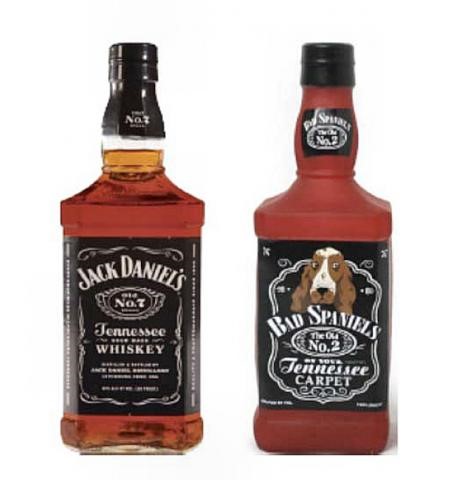On Thursday, June 8, the Supreme Court decided Jack Daniel’s Properties v. VIP Products relating to a “BAD SPANIELS” squeaky dog toy that parodied “JACK DANIEL’S” whiskey.

In a victory for Jack Daniel’s, a unanimous Court vacated summary judgment of noninfringement to VIP and vacated judgment for VIP regarding dilution. Both causes were remanded to the Ninth Circuit for further proceedings.
The decision is also a victory for trademark owners generally, as it sharply limits the Second Circuit’s decision in Rogers v. Grimaldi, 875 F.2d 994 (2d Cir. 1989). Rogers ruled that the title “GINGER AND FRED” for a movie about a fictional dance duo who imitated Ginger Rogers and Fred Astaire was protected speech under the First Amendment that did not violate Ginger Rogers’ trademark and other rights. Rogers held that trademark rights in titles using a celebrity’s name should normally yield to the First Amendment “unless the title has no artistic relevance to the underlying work whatsoever, or, if it has some artistic relevance, unless the title explicitly misleads” as to the source of the work.
The Ninth Circuit, in cases such as Twentieth Century Fox Television v. Empire Distribution, 875 F.3d 1192 (9th Cir. 2017), not only adopted the Rogers test but then applied it as a standalone threshold test prior to assessing whether a use was “likely to cause confusion” under the trademark infringement statute.
The problem for trademark owners was that—in addition to enabling the excising of consumer confusion from trademark infringement—Rogers was applied broadly beyond titles. And the Ninth Circuit liberally found “artistic relevance” in many works. In quoting the leading trademark commentator J. Thomas McCarthy, the Court stated “the Ninth Circuit’s expansion of Rogers ‘potentially encompasses just about everything’ because names, phrases, symbols, designs, and their varied combinations often ‘contain some expressive message’ unrelated to source.”
At oral argument, the Rogers test came under heavy fire from multiple justices. And the United States as amicus curiae stated “we think that Rogers was incorrectly decided, and … the Rogers standard is inconsistent with the text of the Lanham Act … .”
In its decision, the Court stopped short of overruling Rogers. But it sharply limited Rogers, holding that it does not apply “when an alleged infringer uses a trademark … as a designation of source for the infringer’s own goods.” Obviously, this includes VIP’s punny use, which VIP had admitted was a trademark use. But the decision applies more broadly to limit excuses for disregarding trademark rights. As quoted in the decision and colorfully stated in Mattel v. MCA Records, 296 F.3d 894 (9th Cir. 2002), “’[w]hatever first amendment rights you may have in calling the brew you make in your bathtub Pepsi’ are ‘outweighed by the buyer’s interest in not being fooled into buying it.’”
In a concurring opinion, Justices Gorsuch, Thomas and Barrett were more forceful against Rogers, stating that lower courts should handle Rogers “with care” and that—citing the United States’ brief—“it is not obvious that Rogers is correct in all its particulars.”
On trademark dilution, the Court also pulled the Ninth Circuit back to the purposes of trademark law. While the Ninth Circuit categorically concluded that “[w]hen the use of a mark is ‘noncommercial,’ there can be no dilution by tarnishment,” the Court said that noncommercial use does not automatically bar dilution liability. Similarly to trademark infringement, the Court held that noncommercial use “does not shield parody or other commentary when its use of a mark is similarly source-identifying.”
The takeaways are clear—the Rogers test survives, but just barely. It is no longer carte blanche to disregard trademark rights, and Rogers does not apply at all at least when a use is exclusively a source identifying (i.e., trademark) use. This will be a difficult path to navigate going forward, as alleged infringers will be more careful to not admit use as a trademark, and will attempt to argue that their uses are, e.g., ornamental or so dominated by ornamentality that any source identifying use is irrelevant.
For dilution, “noncommercial” use is also no longer a free pass, but the same difficulties in determining the nature of nontrademark versus trademark uses will apply.
Posted: June 12, 2023


